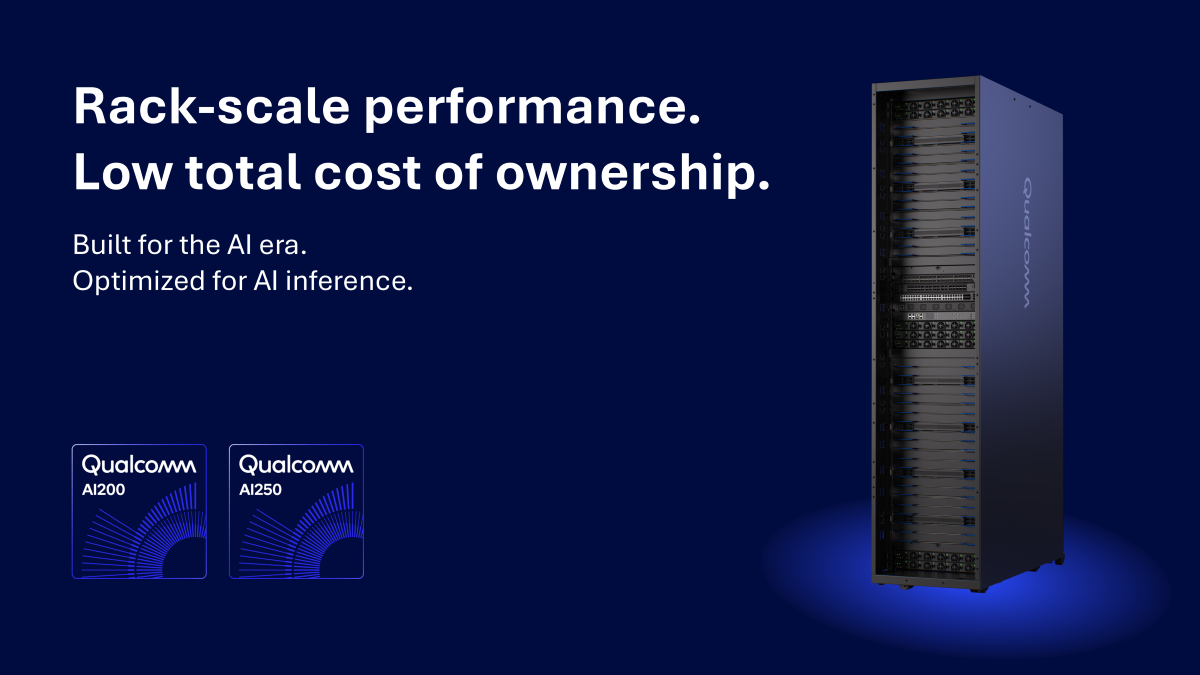The AI chip wars just got a new heavyweight contender. Qualcomm, the company that powers billions of smartphones worldwide, has made an audacious leap into AI data centre chips – a market where Nvidia has been minting money at an almost unfathomable rate and where fortunes rise and fall on promises of computational supremacy.
On October 28, 2025, Qualcomm threw down the gauntlet with its AI200 and AI250 solutions, rack-scale systems designed specifically for AI inference workloads. Wall Street’s reaction was immediate: Qualcomm’s stock price jumped approximately 11% as investors bet that even a modest slice of the exploding AI infrastructure market could transform the company’s trajectory.
The product launch could redefine Qualcomm’s identity. The San Diego chip giant has been synonymous with mobile technology, riding the smartphone wave to dominance. But with that market stagnating, CEO Cristiano Amon is placing a calculated wager on AI data centre chips, backed by a multi-billion-dollar partnership with a Saudi AI powerhouse that signals serious intent.
Two chips, two different bets on the future
Here’s where Qualcomm’s strategy gets interesting. Rather than releasing a single product and hoping for the best, the company is hedging its bets with two distinct AI data centre chip architectures, each targeting different market needs and timelines.
The AI200, arriving in 2026, takes the pragmatic approach. Think of it as Qualcomm’s foot in the door – a rack-scale system packing 768 GB of LPDDR memory per card.
That massive memory capacity is crucial for running today’s memory-hungry large language models and multimodal AI applications, and Qualcomm is betting that its lower-cost memory approach can undercut competitors on total cost of ownership while still delivering the performance enterprises demand.
But the AI250, slated for 2027, is where Qualcomm’s engineers have really been dreaming big. The solution introduces a near-memory computing architecture that promises to shatter conventional limitations with more than 10x higher effective memory bandwidth.
For AI data centre chips, memory bandwidth is often the bottleneck that determines whether your chatbot responds instantly or leaves users waiting. Qualcomm’s innovation here could be a genuine game-changer – assuming it can deliver on the promise.
“With Qualcomm AI200 and AI250, we’re redefining what’s possible for rack-scale AI inference,” said Durga Malladi, SVP and GM of technology planning, edge solutions & data centre at Qualcomm Technologies. “The innovative new AI infrastructure solutions empower customers to deploy AI at unprecedented TCO, while maintaining the flexibility and security modern data centres demand.”
The real battle: Economics, not just performance
In the AI infrastructure arms race, raw performance specs only tell half the story. The real war is fought on spreadsheets, where data centre operators calculate power bills, cooling costs, and hardware depreciation. Qualcomm knows this, and that’s why both AI data centre chip solutions obsess over total cost of ownership.
Each rack consumes 160 kW of power and employs direct liquid cooling – a necessity when you’re pushing this much computational power through silicon. The systems use PCIe for internal scaling and Ethernet for connecting multiple racks, providing deployment flexibility whether you’re running a modest AI service or building the next ChatGPT competitor.
Security hasn’t been an afterthought either; confidential computing capabilities are baked in, addressing the growing enterprise demand for protecting proprietary AI models and sensitive data.
The Saudi connection: A billion-dollar validation
Partnership announcements in tech can be vapour-thin, but Qualcomm’s deal with Humain carries some weight. The Saudi state-backed AI company has committed to deploying 200 megawatts of Qualcomm AI data centre chips – a figure that analyst Stacy Rasgon of Sanford C. Bernstein estimates translates to roughly $2 billion in revenue for Qualcomm.
Is $2 billion transformative? In the context of AMD’s $10 billion Humain deal announced the same year, it might seem modest. But for a company trying to prove it belongs in the AI infrastructure conversation, securing a major deployment commitment before your first product even ships is validation that money can’t buy.
“Together with Humain, we are laying the groundwork for transformative AI-driven innovation that will empower enterprises, government organisations and communities in the region and globally,” Amon declared in a statement that positions Qualcomm not just as a chip supplier, but as a strategic technology partner for emerging AI economies.
The collaboration, first announced in May 2025, transforms Qualcomm into a key infrastructure provider for Humain’s ambitious AI inferencing services – a role that could establish crucial reference designs and deployment patterns for future customers.
Software stack and developer experience
Beyond hardware specifications, Qualcomm is betting on developer-friendly software to accelerate adoption. The company’s AI software stack supports leading machine learning frameworks and promises “one-click deployment” of models from Hugging Face, a popular AI model repository.
The Qualcomm AI Inference Suite and Efficient Transformers Library aim to remove integration friction that has historically slowed enterprise AI deployments.
David vs. Goliath (and another Goliath?)
Let’s be honest about what Qualcomm is up against. Nvidia’s market capitalisation has soared past $4.5 trillion, a valuation that reflects years of AI dominance and an ecosystem so entrenched that many developers can’t imagine building on anything else.
AMD, once the scrappy challenger, has seen its shares more than double in value in 2025 as it successfully carved out its own piece of the AI pie.
Qualcomm’s late arrival to the AI data centre chips party means fighting an uphill battle against competitors who have battle-tested products, mature software stacks, and customers already running production workloads at scale.
The company’s smartphone focus, once its greatest strength, now looks like strategic tunnel vision that caused it to miss the initial AI infrastructure boom. Yet market analysts aren’t writing Qualcomm’s obituary. Timothy Arcuri of UBS captured the prevailing sentiment on a conference call: “The tide is rising so fast, and it will continue to rise so fast, it will lift all boats.” Translation: the AI market is expanding so rapidly that there’s room for multiple winners – even latecomers with compelling technology and competitive pricing.
Qualcomm is playing the long game, betting that sustained innovation in AI data centre chips can gradually win over customers looking for alternatives to the Nvidia-AMD duopoly. For enterprises evaluating AI infrastructure options, Qualcomm’s emphasis on inference optimisation, energy efficiency, and TCO presents an alternative worth watching – particularly as the AI200 approaches its 2026 launch date.
(Photo by Qualcomm)
See also: Migrating AI from Nvidia to Huawei: Opportunities and trade-offs
Want to learn more about AI and big data from industry leaders? Check out AI & Big Data Expo taking place in Amsterdam, California, and London. The comprehensive event is part of TechEx and is co-located with other leading technology events, click here for more information.
AI News is powered by TechForge Media. Explore other upcoming enterprise technology events and webinars here
Read the full article here















